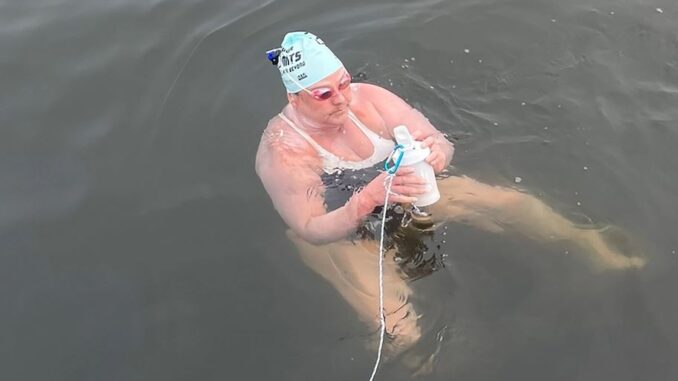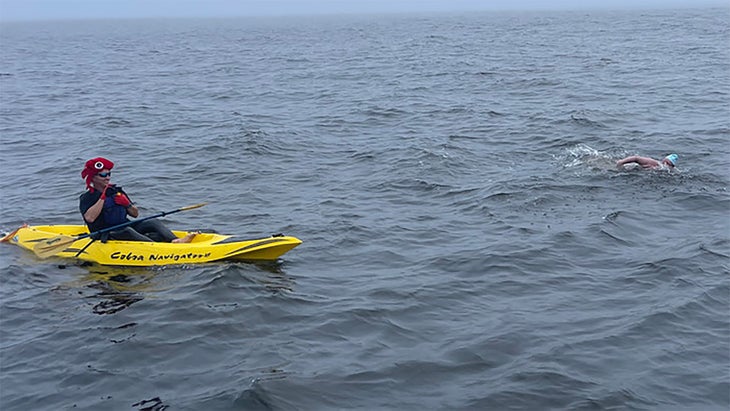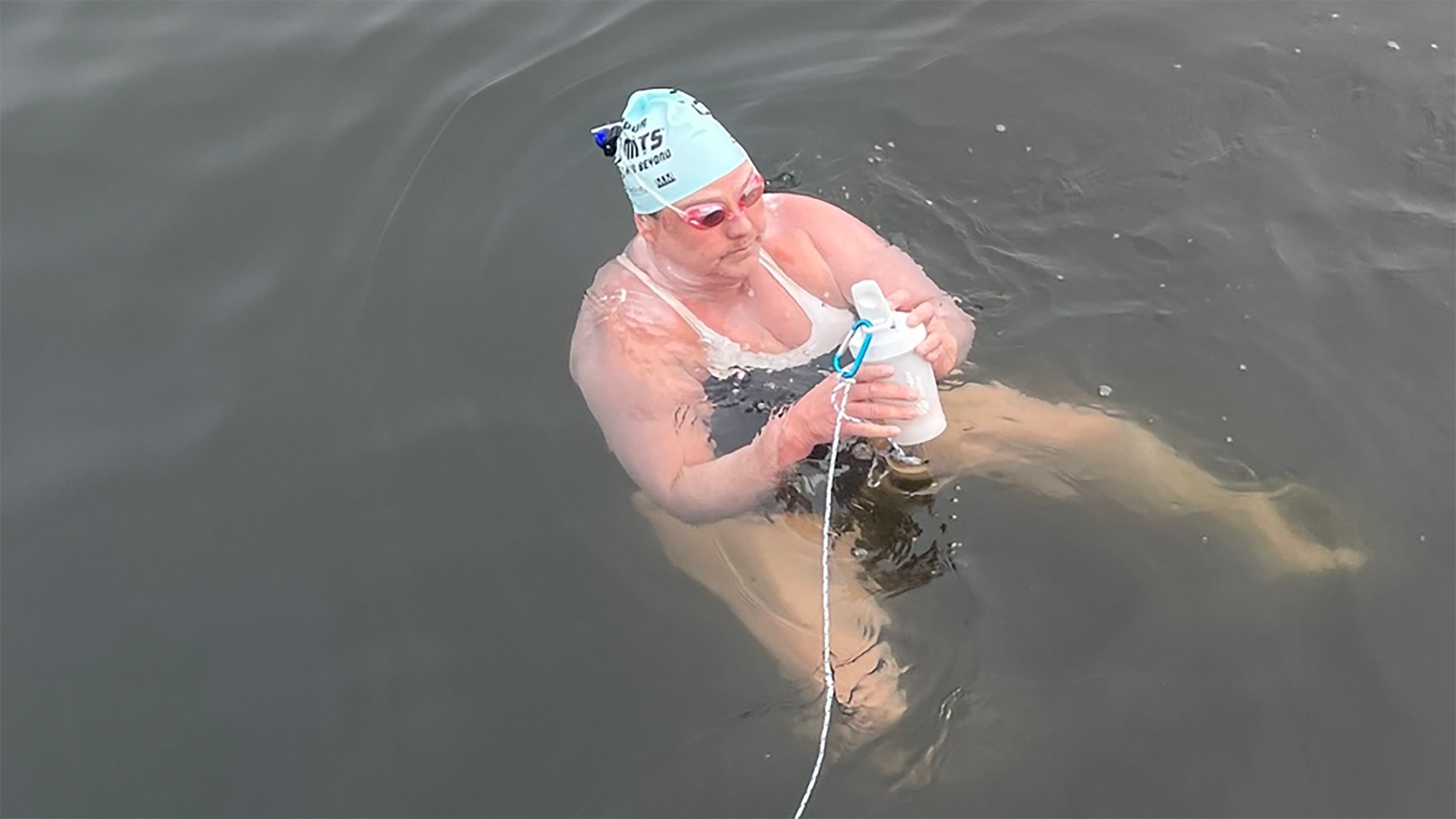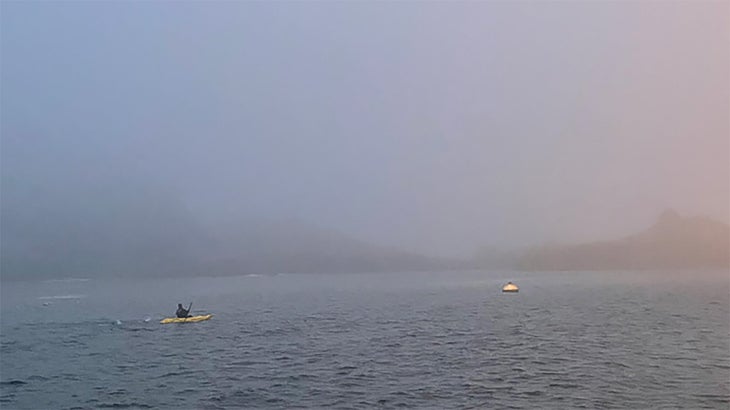
This Grandmother Swam 30 Miles Through Shark-Infested Waters to Set a Record
Five questions with Amy Appelhans Gubser, the 55-year-old California woman who became the first person to swim from the San Francisco Bay to the Farallon Islands

Last week I read that a 55-year-old woman named Amy Appelhans Gubser had swum from San Francisco to the Farallon Islands—the craggy archipelago at the center of Susan Casey’s epic 2005 book The Devil’s Teeth. Whenever I read about the Farallones, I envision the school bus-sized great white sharks that swim in the murky waters around the islands, which Casey profiled in her book. When I read about Appelhans Gubser’s amazing feat, all I could conjure were those sharks. I just had to ask her about them.
Appelhans Gubser, a nurse and grandmother who lives in Pacifica, completed the 29.6-mile swim from the Golden Gate Bridge to the islands on May 11 in 17 hours, three minutes. I caught up with Appelhans Gubser to discuss the massive swim and the big fish that undoubtedly swam below her.
What was your greatest fear during the swim?

The elephant in the room is white sharks, and they were in the back of my mind at all times during the swim. We didn’t take the shark thing lightly—I had a savvy crew that kept watch for them from a boat and kayak. They were ready to jump into the water to help me if I needed, but we had no shark sightings the whole time. My second fear was the cold. I trained to swim in cold but the water was 43 degrees that day, and that was unexpected and something I was not ready for. Then, I had to trust that my team was keeping me on course. We had three different instruments making sure we were going the right way. We were out of cellphone range so nobody could call us to tell us we were going the wrong way.
How did you come up with the idea for the swim?
I’ve been around the ocean since I was ten years old. I was an ocean lifeguard in high school and college, and I swam at the University of Michigan. After I graduated I was done with the sport. I didn’t get back into the water for 24 years, and when I did return I was doing open-water swimming. I just fell in love with it and started doing more events like the open-water swims across Lake Tahoe and Monterey Bay. I can see the Farallon Islands from my house when it’s clear, and I’ve always joked with my husband that I can swim there. Five years ago I started planning and training for the crossing. I knew my body could withstand the cold and the distance. I sought out open-water swimming mentors for guidance. I got resources through the Marathon Swimming Federation, and then Covid broke out in 2020 and I couldn’t rent a boat. It was too bad because I was in the best shape of my life, but I was foiled. Then, the next two years I had to cancel because of strong winds. It was a challenge I wanted to do, but things never lined up.#

What elements had to come together for you to even attempt it?
I had to wait for the weather systems and the currents to be right, or else you’ll swim as hard as you can and you won’t go anywhere. Wave height was another factor because the ocean can’t be too bouncy. Sometimes the current was OK but the wave interval was too tight. One day it was clear but the waves were six feet every nine seconds. On the day we went it was four feet every 12 seconds, which is doable. And then there’s the wind. If you get a prevailing southerly wind then you get foggy weather. If it’s from the north then you get blasted by Alaskan air. It can be beautiful in San Francisco but out at Point Reyes it’s 40 mile-per-hour winds. This year we spent three months monitoring surface currents. A week before my swim we could see conditions were magically aligning, and by Wednesday, May 8 we knew we were a go for Saturday the 11th. But I had a problem: the captain I had contacted for the follow boat said he had a different charter that day. I had to scramble and get a fishing captain who signed up and said “yes.”

How did you keep your mind occupied during the 17 hour swim?
Sometimes I’m thinking of nothing, other times I’m solving the world’s problems. A swarm of bats flew around us at dawn and I kept thinking it was the universe telling me I’m batshit crazy. I found that joke funny for way too long because I had nothing else to entertain my thoughts. My team would tell me jokes to keep my spirits up. I’d try to count but I’d always lose count at 77 so I’d start again.
What is the appeal of marathon open-water swimming?
As a pool swimmer, you’re following time intervals but you never see how much distance you’ve actually covered. When you do open-water swimming you can look across a body of water and see where you’ve come from. It’s so much more profound. In pool swimming you’re going for time, but in open-water swimming time doesn’t mater because you’re up against so many elements you cannot control. Your job is just to persevere so you can eventually break through. I like that.
Leave a Reply